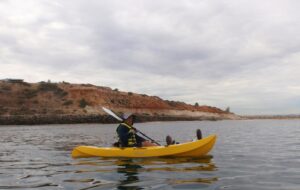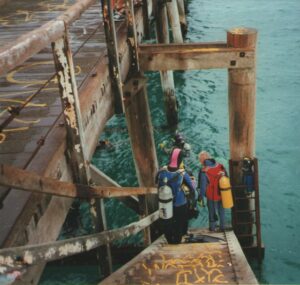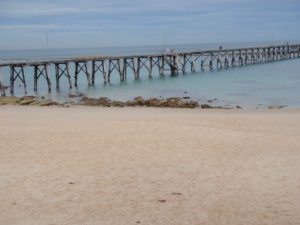My Early Diving Days
by Steve Reynolds
Witton Bluff is the high point on the coast between Port Noarlunga and Christies Beach. It is named after the 1839 wreck of the David Witton.

I did my ‘first’ sea snorkel there in January 1978. I say ‘first’ because I had briefly used one of those ‘ping pong’ mask and snorkels as a child in England many years earlier. Nothing came of those early snorkels at all. Things were, however, different this time round.
It was the Australia Day holiday long weekend. I went to Lang’s Skindiving Service centre at Christies Beach on the Saturday morning to buy some basic snorkelling gear. I bought a single lens facemask, a snorkel, a pair of full-foot flippers, a weight-belt and a couple of lead weights.
The main reason for these purchases was so that I at least had a few items to call my own when I did a test sea dive at Port Noarlunga jetty the following weekend. The fact is that I had been doing a week-long basic scuba course through Lang’s during the week but, to cut a long story short, had lost any little confidence that I may have started with.
The plan was to gain some confidence by owning a little gear of my own, rather than having to borrow a complete set of diving gear. The bonus was that my little purchase allowed me to go down to Witton Bluff to try the gear out for the first time.
It was probably a hot summer day and I ventured into the water in just a pair of bathers to try out my snorkelling gear. I don’t recall how long my swim lasted, but I must’ve been immediately ‘hooked’. I gained enough confidence to attempt my test sea dive the following weekend.
On the day of my test sea dive, I was ‘allocated’ to a dive instructor who I hadn’t met before in a one on one test dive. I don’t even recall his name. I had missed out on some of my pool training during the week before my snorkel. I may have had to borrow wetsuits and scuba gear for the test, but at least I had my own snorkelling gear that I had used just once previously.
I say that I ‘may’ have had to borrow scuba gear, but I’m not certain about that part. I know that I soon had a steel tank and regulator because I was able to layby them at Lang’s and they allowed me to use them whilst I was paying them off. I simply had to return them back to the shop after each dive. More on this topic later.
Middle steps at Port Noarlunga jetty (1997)
We dived at Port Noarlunga jetty on the first Saturday in February. My one on one instructor led me underwater from the jetty’s middle steps to the reef where he pointed out a stingray in a hole in the reef. Now I was really ‘hooked’!
We both swam the length of the jetty a couple of times before I was called on to demonstrate that I had learned how to clear my mask underwater. Satisfied that I had the right idea, the instructor signalled that we had completed the test and it was time to exit the water.
Middle steps at Port Noarlunga jetty
Back at Lang’s Skindiving Service centre, I pondered whether or not I had successfully passed the test dive. I was pleasantly surprised when I was handed a certificate and a wallet card indicating that I had “completed the Basic Scuba Training School”.
My certificate indicated that I had done all of the theory, practical pool sessions, sea dive and medical examination. It enabled me to join a Society (then MARIA (SA) ) dive at The Bluff the next day. Diving with the Society is where I gained most of my diving experience. More on this topic later.
I think that I just used gardening gloves for my dives. I don’t recall when I got my first pair of dive boots. The Voit steel tank and Voit regulator that I was able to layby at Lang’s did not include a BCD or octopus reg or gauges. There was just a primary reg and the tank came with a plastic back plate with straps. The tank had a J-valve which used a reserve lever for switching to reserve air when the contents of the tank became low. As stated earlier, Lang’s allowed me to use them whilst I was paying them off. I simply had to return them back to the shop after each dive. I don’t recall who was responsible for rinsing them in freshwater though.
It all seemed like a good arrangement until I was informed one day that they had ‘lost’ my regulator and would have to give me another one in its place. I forget why, but I was a little disappointed with the replacement reg.
We didn’t use BCDs at all in those early days. Divers were, however, soon starting to wear those horse-collar BCDs. I was offered a snorkelling horse-collar BCD with a scuba-feed attachment added to it, and that served me well for a little while.
My first dives were done in hired wetsuits. This was awkward and expensive for me at the time. At least air fills only cost $1 at the time. I soon bought a (5mm?) Moray long-john wetsuit on Bankcard so that I only had to hire a jacket for my dives. The cost of the hire was one thing, but finding a good fit was not always easy.
I would’ve bought some dive gloves, boots and better fins at some stage. It wasn’t too long before I bought a (5mm?) Moray wetsuit jacket on Bankcard, making my dive gear almost complete. I say ‘almost’ because I had to manage without a contents gauge or depth gauge. I eventually bought an old stem-type contents gauge from a Society member.
My steel tank and single reg both served me well for many years. My then-wife took up snorkelling and diving some 5 or 6 years after I had started, and there was the cost of her diving gear to consider. She wanted the best of everything, within reason. It was about this time that I became President of our Society and the pressure was on to look the part. We both invested in a lot of new dive gear, including BCDs, octopus regs, gauges, etc..
I was now ready to look the part for a boat dive with the Adelaide University Scuba Club, except that I injured my back trying to shift a large rock at The Bluff the day before. This meant that I could only stay in the Uni’s boat and watch the others dive whilst I couldn’t.
I forgot to mention that I was ‘thrown in the deep end’ for my first dives with the Society. That first dive at The Bluff the day after my test sea dive was a ‘research dive’ involving recording whatever could be seen within a quadrat. This was something that I had absolutely no experience with, and I managed to get myself tangled up in a fisherman’s fishing line.
Two week’s later, we went diving at Myponga Beach where we had to enter from rocks. Our 80-minute dive was spent swimming a long way in open water. My next dive was a month later, but it was to be my first night dive, despite being only my fourth dive. I bought a torch for the dive, but I didn’t know how to prepare it for submersion. I was buddied up with a 14-year old diver who hadn’t done a night dive before either. My torch soon flooded and stopped working, but we pressed on regardless. We got a little lost and were late returning to the jetty where our fellow members had become somewhat concerned about our welfare.
Just over one week later, we went to (the old) Rapid Bay jetty to dive with a visitor from Victoria. He decided that rather than walk the full length of the jetty, he would leap over the fence and smash his glass collecting jars as he hit the water. I don’t recall much more about the 60-minute dive itself other than thinking that it was pretty deep by comparison with me previous dives. My log book tells me that this was the day that I dived with TV’s Glen Ridge before he became famous.
It was three weeks later that we dived at Moana Reef and I was part of a 3-man team. One of my team (temporarily?) lost his weight belt whilst I was having problems with both my mask and my regulator.
The following month, we dived at the Glenelg Blocks. This involved a long surface swim from the jetty to the blocks. One week later, we dived at Fishery Beach. One month later we returned to Glenelg jetty. Even though we tried to stay under the jetty this time, all divers lost their buddies at times as the vis was just 1-metre.
I think that I made do right through winter with 5mm wetsuits. My first winter of diving was limited to about once per month. I don’t recall when I managed to get 7mm suits at all. I bought a Scuba Divers Federation of AUSTRALIA dive log book soon after starting my diving. It got off to a scrappy start, but it soon settled down into an accurate record of my dives, and the basis for this article. I never imagined back then that I would one day become Treasurer for the SDF of AUSTRALIA, or the long-term Secretary for the SDF of SA.
I could go on forever, but I won’t. This started off being just about Witton Bluff, but it became a record of my early dives. I will write more about Witton Bluff in another article.





Great article about your rather infamous early diving experiences Steve .
Thanks David, this needs to be read in conjunction with one at https://mlssa.org.au/2017/03/03/recollections-of-my-first-few-dives/
[…] reported in My Early Diving Days , Witton Bluff is the high point on the coast between Port Noarlunga and Christies Beach. It is […]
[…] walkway goes just past the reef at Witton Bluff at present.” As I stated in My Early Diving Days , “Witton Bluff is the high point on the coast between Port Noarlunga and Christies Beach. It […]